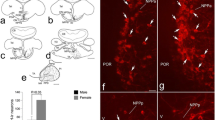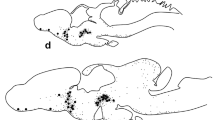Summary
Previous studies have shown that a circumscribed region of the anterior hypothalamus of the rhesus monkey is lined by tanycyte ependyma and it has been suggested that this ependyma which links the third ventricle with the pars tuberalis may have a functional role in the hypothalamic regulation of anterior pituitary function (Anand Kumar and Knowles, 1967a). In view of the known sexual differences in the hypothalamic regulation of pituitary gonadotropin secretion the present investigation was made to determine whether any structural differences were evident in the tanycyte ependyma in male and female rhesus monkeys.
The results of this investigation are based on light and electron microscopic studies of the hypothalamus in 24 rhesus monkeys comprising 12 adult females, 11 sexually mature males and a two month old sexually immature male.
The tanycyte ependyma in the rhesus monkey is double layered. There are bulbous projections on the ventricular surface of the cells in the ependymal layer nearest to the ventricle (the first layer of ependyma). These bulbous projections vary in size in relation to the menstrual cycle. They are well developed during mid-cycle and regressed during menstruation. In the males, where the secretion of pituitary gonadotropins does not occur cyclically as in the females, there was no marked variation in the bulbous projections between different individuals as in the female monkeys.
In the sexually mature males, but not in the females, the two layers of ependyma are separated by a distinct space. The absence of such a space in the sexually immature male suggests that this difference may be related to sexual maturity.
In the adult males the cells in the ependymal layer below the first layer of ependyma have microvilli which extend into the space between the ependymal layers. In the females where such a space is not present, microvilli were not evident.
The precise functional significance of the tanycyte ependyma is not known. It is hoped that the results of the present investigation would draw attention to the need for a more detailed examination of the physiological role of the tanycyte ependyma in relation to reproduction.
Similar content being viewed by others
References
Anand Kumar, T. C., and F. G. W. Knowles: A system linking the third ventricle with the pars tuberalis of the rhesus monkey. Nature (Lond.) 215, 54–55 (1967a).
— —: Experimental modification of an area of specialized ependyma in the hypothalamus of the rhesus monkey. Gen. comp. Endocr. 9, 513 (1967b).
Brightman, M. W., and S. L. Palay: The fine structure of ependyma in the brain of the rat. J. Cell Biol. 19, 415–439 (1963).
Critchlow, B. W.: Ovulation induced by hypothalmic stimulation in the anaesthetized rat. Amer. J. Physiol. 195, 171–174 (1965).
Davidson, J. M.: Control of gonadotrophin secretion in the male. In: Neuroendocrinology vol. I (L. Martini and W. F. Ganong, eds). New York and London: Academic Press 1966.
Flerko, B.: Control of gonadotrophin secretion in the female. In: Neuroendocrinology, vol. I (L. Martini and W. F. Ganong, eds.). New York and London: Academic Press 1966.
Hagadoorn, J.: Seasonal changes in the ependyma of the third ventricle of the skunk, Mephitis mephitis nigra. Anat. Rec. 151, 453–454 (1965).
Halsz, B., L. Pupp, and S. Uhlarik: Hypophysiotrophic area in the hypothalamus. J. Endocr. 25, 147–154 (1962).
Harris, G. W., and H. J. Campbell: The regulation of the secretion of luteinizing hormone and ovulation. In: The pituitary gland, vol. II (G. W. Harris and B. T. Donovan. eds.). London: Butterworth & Co. 1966.
Knowles, F. G. W., T. C. A. Kumar, and C. Jones: Structure and ultrastructure of an area of specialized ependyma in the hypothalamus in relation to reproductive activity. Gen. comp. Endocr. 9, 526 (1967).
Leblond, C. P., Holde-Puchtler, and Y. Clermont: Structures corresponding to terminal bars and terminal web in many types of cells. Nature (Lond.) 186, 784–788 (1960).
Palay, S. L., S. M. McGee-Russel, S. Gordon, and M. A. Grillo: Fixation of neural tissues for electron microscopy by perfusion with solutions of osmium tetroxide. J. Cell Biol. 12, 385–431 (1962).
Ryter, A., et E. Kellenberger: L'inclusion polyester pour l'ultramicrotomie. J. Ultrastruct. Res. 2, 200–214 (1958).
Sabatini, D. D., K. Bensch, and R. J. Barrnett: The preservation of cellular structure and enzymatic activity by aldehyde fixation. J. Cell Biol. 17, 19–58 (1963).
Szentágothai, J., B. Flerko, B. Mess, and B. Halasz: Hypothalamic control of the anterior pituitary, III. ed. Budapest: Akademiai Kiado 1968.
Tennyson, W. M., and G. D. Pappas: An electron microscope study of ependymal cells of the foetal, early post-natal and adult rabbit. Z. Zellforsch. 56, 595–618 (1962).
Wittkowski, W.: Zur Ultrastruktur der ependymalen Tanycyten und Pituicyten sowie ihre synaptische Verknüpfung in der Neurohypophyse des Meerschweinchens. Acta anat. (Basel) 67, 338–360 (1967).
Author information
Authors and Affiliations
Additional information
The expenses for this investigation were met from a grant made by the Ford Foundation to Professor Sir Solly Zuckerman and the electron microscope was provided by the Medical Research Council. I am indebted to Sir Solly for his interest in this work.
Rights and permissions
About this article
Cite this article
Anand Kumar, T.C. Sexual differences in the ependyma lining the third ventricle in the area of the anterior hypothalamus of adult rhesus monkeys. Z. Zellforsch 90, 28–36 (1968). https://doi.org/10.1007/BF00496700
Received:
Issue Date:
DOI: https://doi.org/10.1007/BF00496700




